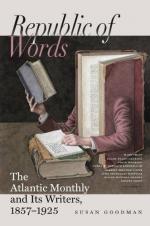useful insects. That is, the limited partnership
of Oxygen, Hydrogen, & Co., under which they agreed
to carry on the operations of sheep, fox, or fish,
having terminated by the death of the animal, the
partners make immediate use of their liberty and go
off in inorganic form in search of new engagements,
leaving sulphur, phosphorus, and the other subordinate
elements of the animal, to shift for themselves.
They were in the employ of a sheep; they will now
carry on a man or an oak-tree, a colony of insects,
or something else. Under the form of carbonate
of ammonia, the four elements diffuse themselves through
the air, or are absorbed by the earth, and offer themselves
at once to the roots and leaves of the trees, as ready
to go on with their vivifying operations as they were
in behalf of the animals. There are some plants
which seem not to be left to the chances of securing
their nourishment from the carbonate of ammonia that
the air and the soil contain, but are contrived so
as to entrap living animals and hold them fast while
they undergo decomposition, so that all their gases
may be absorbed by them alone. Thus, “the
little Sundew exudes a gluey secretion from the surface
of its leaves, which serves to attract and retain
insects, the decay of whose bodies seems to contribute
to its existence.” And the Dionaea, or
Venus’s Fly-trap of the Southern States, has
some leaves which fold together upon any insect that
alights upon their upper surface; and by means of
a row of long spines that fringes the leaves, they
prevent his escape. The more active the struggles
of the captive, the closer grows the hold of the leaf,
and speedily destroys him. The plant appears to
derive nutriment from the decomposition of its victims.
“Plants of this kind, which have been kept in
hot-houses in England, from which insects were carefully
excluded, have been observed to languish, but were
restored by placing little bits of meat upon their
traps,—the decay of these seeming to answer
the same purpose.”
The four elements already referred to are by no means
all the material ingredients of animal bodies.
There are, also, phosphorus, lime, magnesia, soda,
sulphur, chlorine, and iron; and if you believe some
chemists, there is hardly a mineral in common use that
may not be found in the human body. We doubt,
however, whether lead, arsenic, and silver are there,
without the intervention of the doctor.
What becomes of the phosphorus and the rest, when
an animal dies? Oh, they take up new business,
too. They are as indispensable to the animal
frame as the four most prominent ingredients.
We eat a great deal of bread and meat, and a little
salt,—but the little salt is as important
to continued life as the large bread. There is
hardly a tissue in the body from which phosphorus,
in combination with lime, is absent; so that the composition
of lucifer-matches is by no means the most important
use of this element. The luminous appearance which
some putrefying substances, particularly fish, present
at night, is due to the slow combustion of phosphorus
which takes place as this element escapes into the
air from the decomposing tissues.




